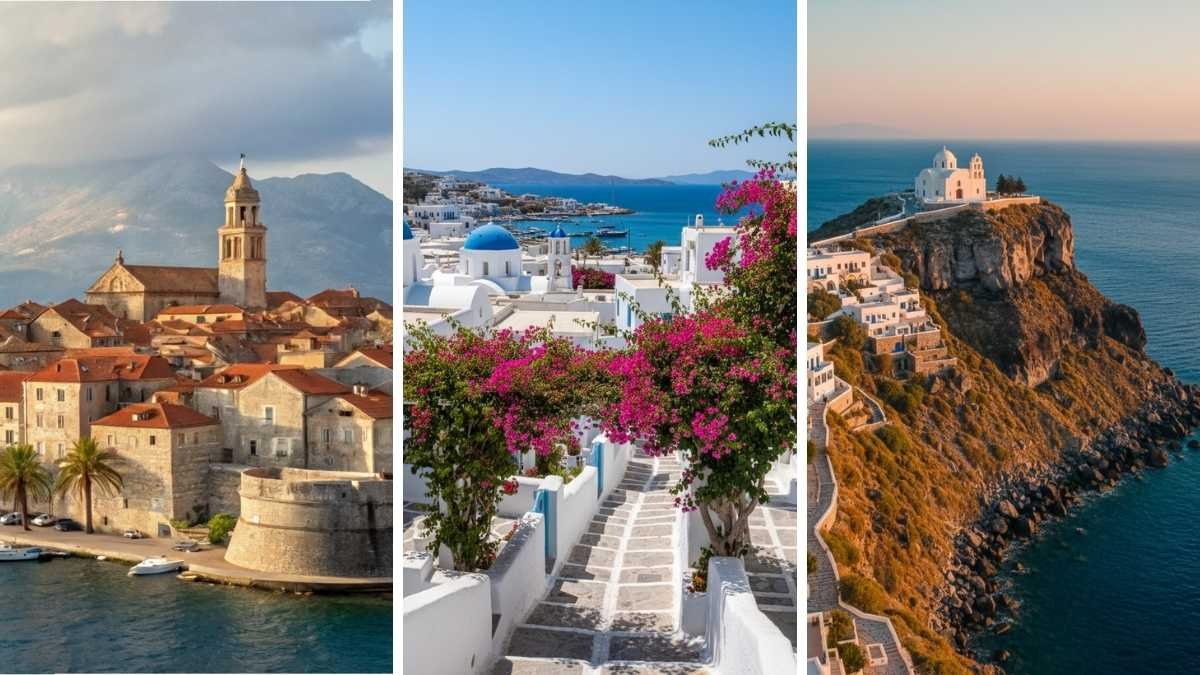
There’s a certain kind of magic in discovering a place that feels like a secret — where whitewashed homes still glow under the same sun, and the sea shimmers without a crowd in sight.
It’s that rare sweet spot between serenity and spectacle, where you can sip coffee by the water and actually hear the sound of your own thoughts.
For those chasing the soul of Santorini but craving space to breathe, these islands offer the same cinematic blues and cliffside charm — minus the chaos. They’re the kind of destinations that make you fall in love quietly, but completely.
1. Milos, Greece
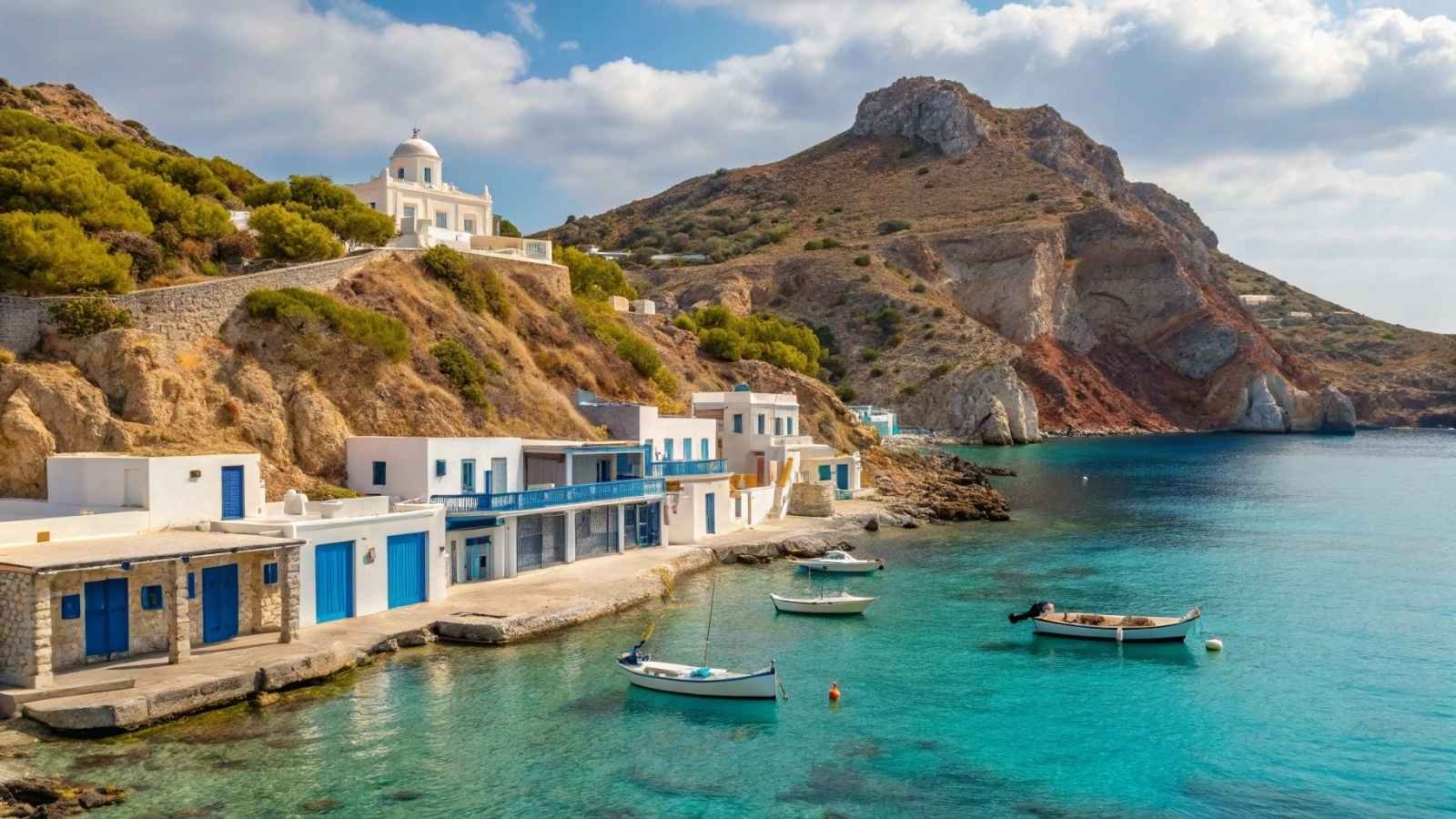
If Santorini is the glossy postcard everyone’s seen, Milos is the secret Polaroid you keep to yourself. With over 70 beaches — yes, seventy — this volcanic island feels like a natural art gallery carved by time. Sarakiniko Beach, with its moonlike white rock formations and turquoise coves, feels like a dreamscape, but without the crowds blocking your shot. The fishing village of Klima, with its colorfully painted boathouses, is pure Cycladic charm — just calmer, quieter, and far more affordable than Oia.
Milos has a slower rhythm that pulls you in. You’ll spend more time chatting with locals over grilled octopus than queuing for sunsets. The small harbor town of Adamas is lively but never frantic — it’s where you can base yourself for easy day trips around the island. Whether you’re snorkeling in crystal-clear coves or exploring hidden sea caves by boat, Milos gives you that “Mediterranean fantasy” — but it’s still yours alone.
What to know:
- Best months to visit: May to early October (June and September are perfect for warm water + fewer crowds)
- Getting there: 40-minute flight or 3–4-hour ferry from Athens
- Where to stay: Plaka for charm and views, Adamas for convenience
- Vibe: Romantic, adventurous, authentic
- Must-do: Boat tour around Kleftiko Caves — it’s like floating through marble
2. Folegandros, Greece
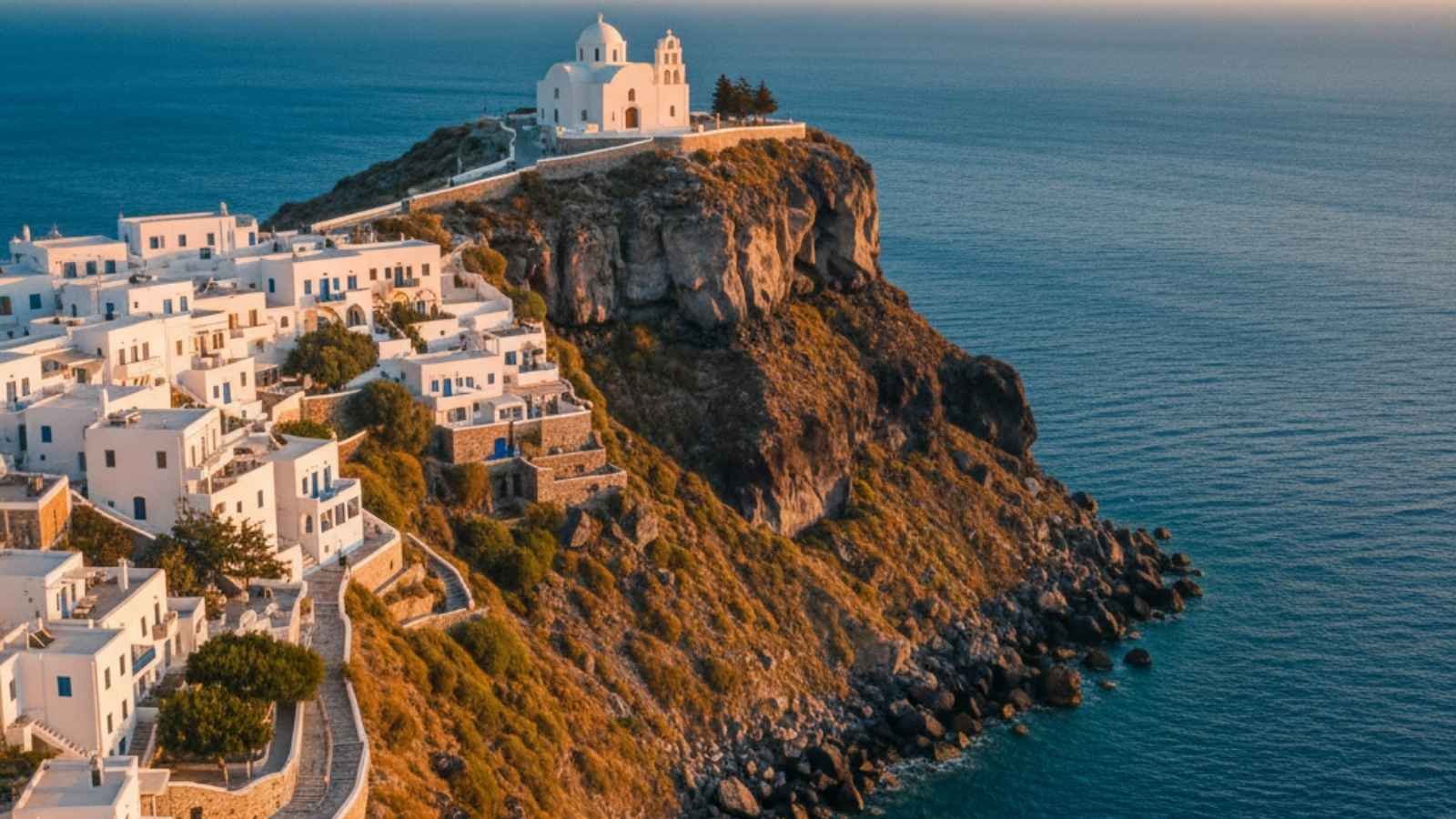
Folegandros feels like what Santorini must’ve been before Instagram found it. Small, rugged, and deeply serene, this is a place where time actually slows down. The cliffside Chora, one of the most beautiful villages in the Cyclades, sits perched like a white crown over the Aegean. Wander through its narrow lanes in the evening and you’ll find locals gathered in cozy tavernas under fairy-lit terraces — no tour buses, no rush, just pure island life.
There’s a raw beauty here — steep cliffs, wild herbs perfuming the air, and that endless blue horizon that never gets old. You can hike from Chora to secluded beaches like Agali or Livadi, both framed by dramatic rock faces. The whole island gives off that same cinematic light that made Santorini famous, but it’s quieter, more soulful, and wonderfully personal.
What to know:
- Best months to visit: June, July, and early September
- Getting there: Ferry from Santorini (1 hour) or from Piraeus (4–5 hours)
- Where to stay: Chora for the views, Karavostasis for easy ferry access
- Vibe: Romantic solitude with rugged beauty
- Must-do: Sunset walk to the Church of Panagia — the view is breathtaking, minus the crowd
3. Paros, Greece
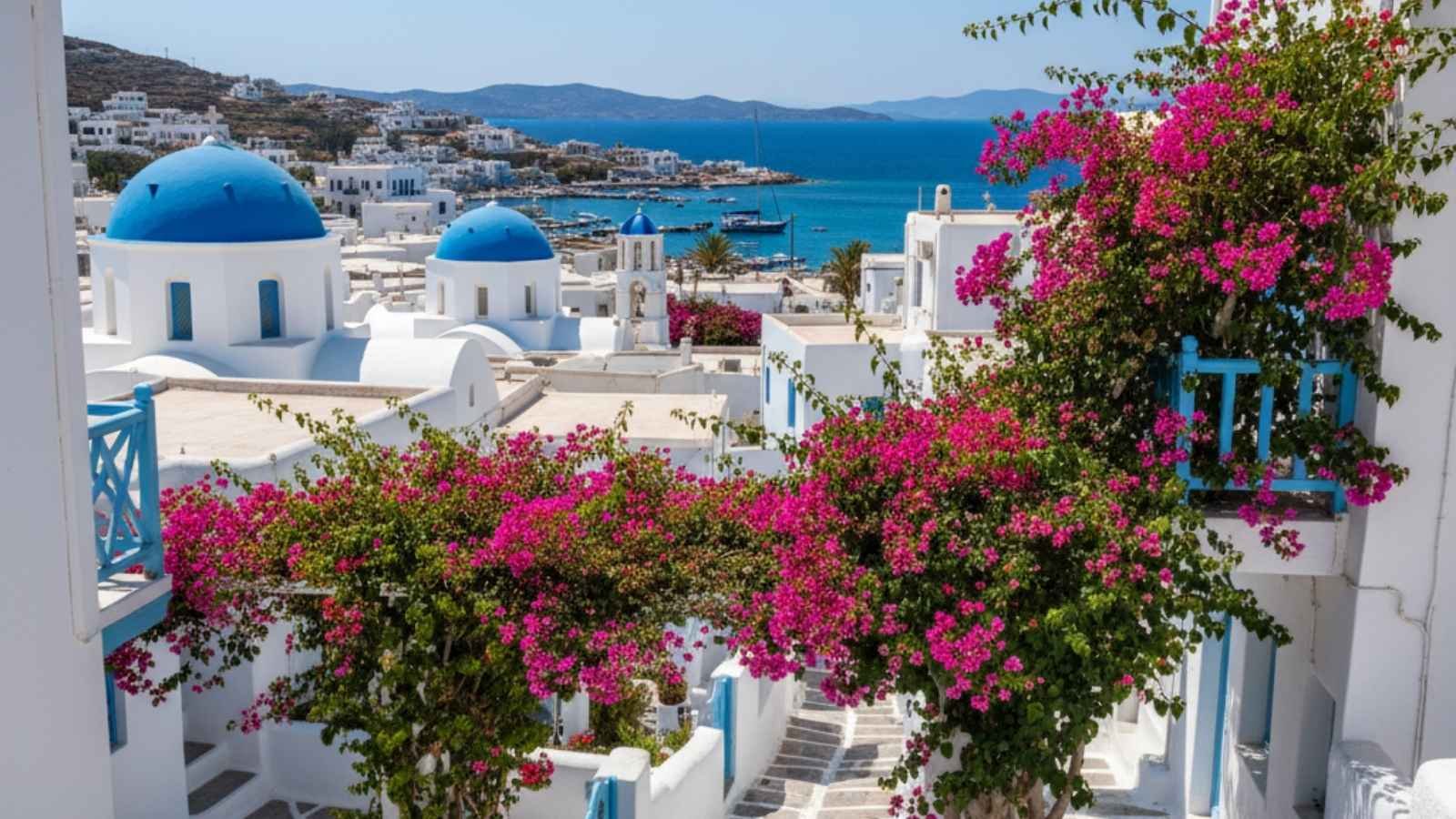
Paros is like the best friend version of Santorini — stylish, social, and endlessly photogenic, but without the exhausting crowds. Its blend of charm and convenience makes it one of the most balanced islands in Greece. The capital, Parikia, has lively cafes, bougainvillea-draped lanes, and whitewashed houses that give you that signature Cycladic vibe. But the real soul of Paros shines in Naoussa, a seaside village where fishermen still mend nets beside trendy cocktail bars.
Paros also scores big for day-to-day ease: it’s walkable, family-friendly, and great for foodies. You can explore the neighboring islet of Antiparos by ferry for a quick escape or go windsurfing in Golden Beach. It’s modern enough for comfort, yet still traditional enough to feel Greek at its core.
What to know:
- Best months to visit: May to October (avoid peak crowds in August)
- Getting there: Direct ferry from Athens or a short hop from Santorini/Mykonos
- Where to stay: Naoussa for charm, Parikia for nightlife
- Vibe: Trendy yet laid-back
- Must-do: Dinner at a seaside taverna in Naoussa’s old port — still one of the most romantic scenes in Greece
4. Vis, Croatia
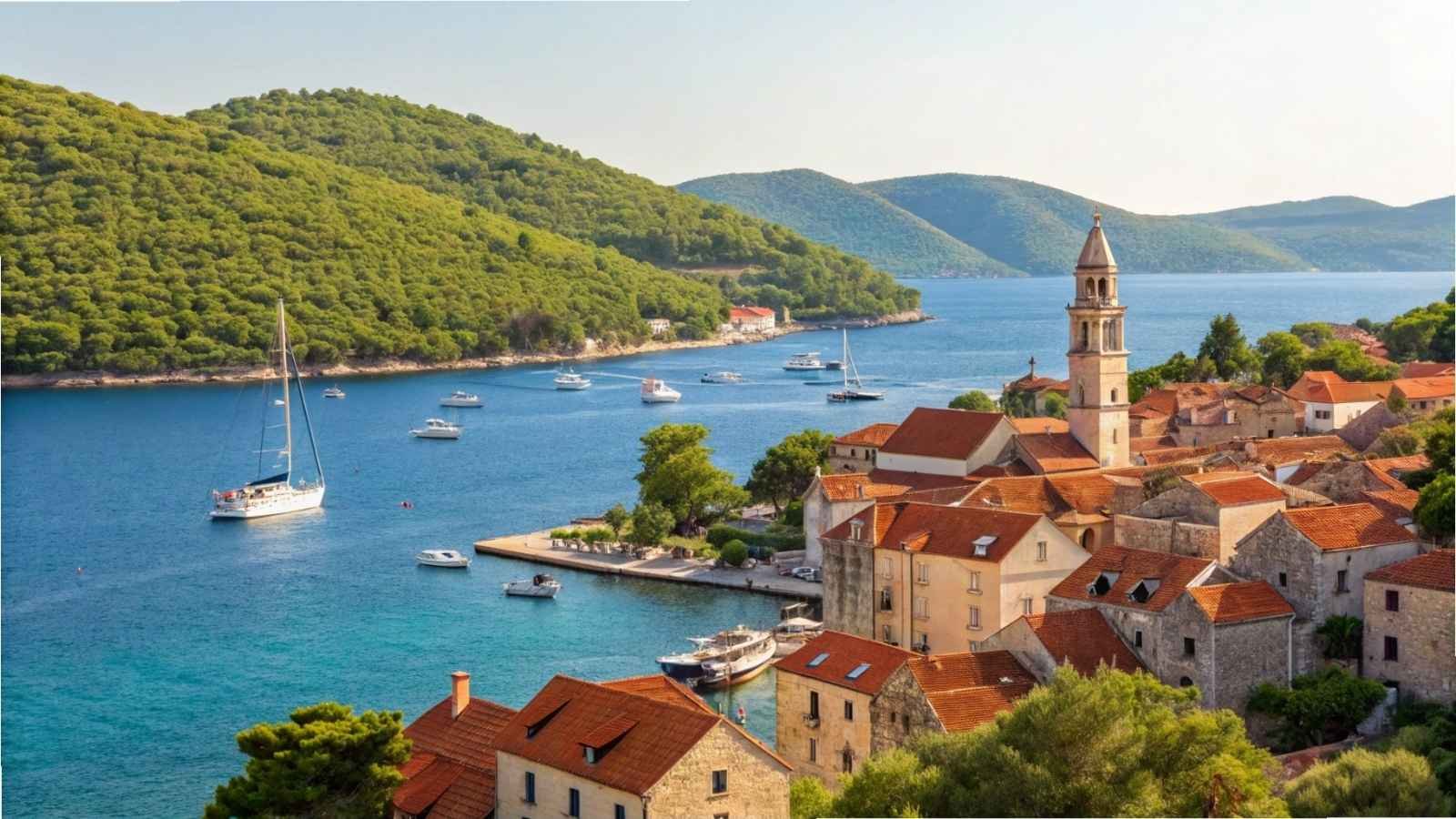
If Greece is about sun-kissed romance, Vis is about slow, cinematic mystery. Closed to tourists until 1989 due to its military past, Vis feels like a preserved time capsule — one that’s just now being rediscovered. The island’s stone houses, quiet harbors, and untouched landscapes are pure Adriatic poetry. You’ll find boutique hotels tucked into old naval quarters and vineyards where locals still handpick grapes.
The real magic? The Blue Cave on the nearby island of Biševo — a glowing sea grotto where sunlight turns the water into molten sapphire. Add in the crystal coves of Stiniva Bay, framed by limestone cliffs, and you’ve got one of Croatia’s most enchanting getaways. The vibe here is less glitz, more soul — it’s where people come to disappear, recharge, and fall back in love with the simple things.
What to know:
- Best months to visit: May to September (September is best for warm water + calm mood)
- Getting there: 2.5-hour ferry from Split
- Where to stay: Vis Town for charm, Komiža for coastal quiet
- Vibe: Authentic, peaceful, cinematic
- Must-do: Early morning swim at Stiniva Bay before the tour boats arrive
5. Korčula, Croatia
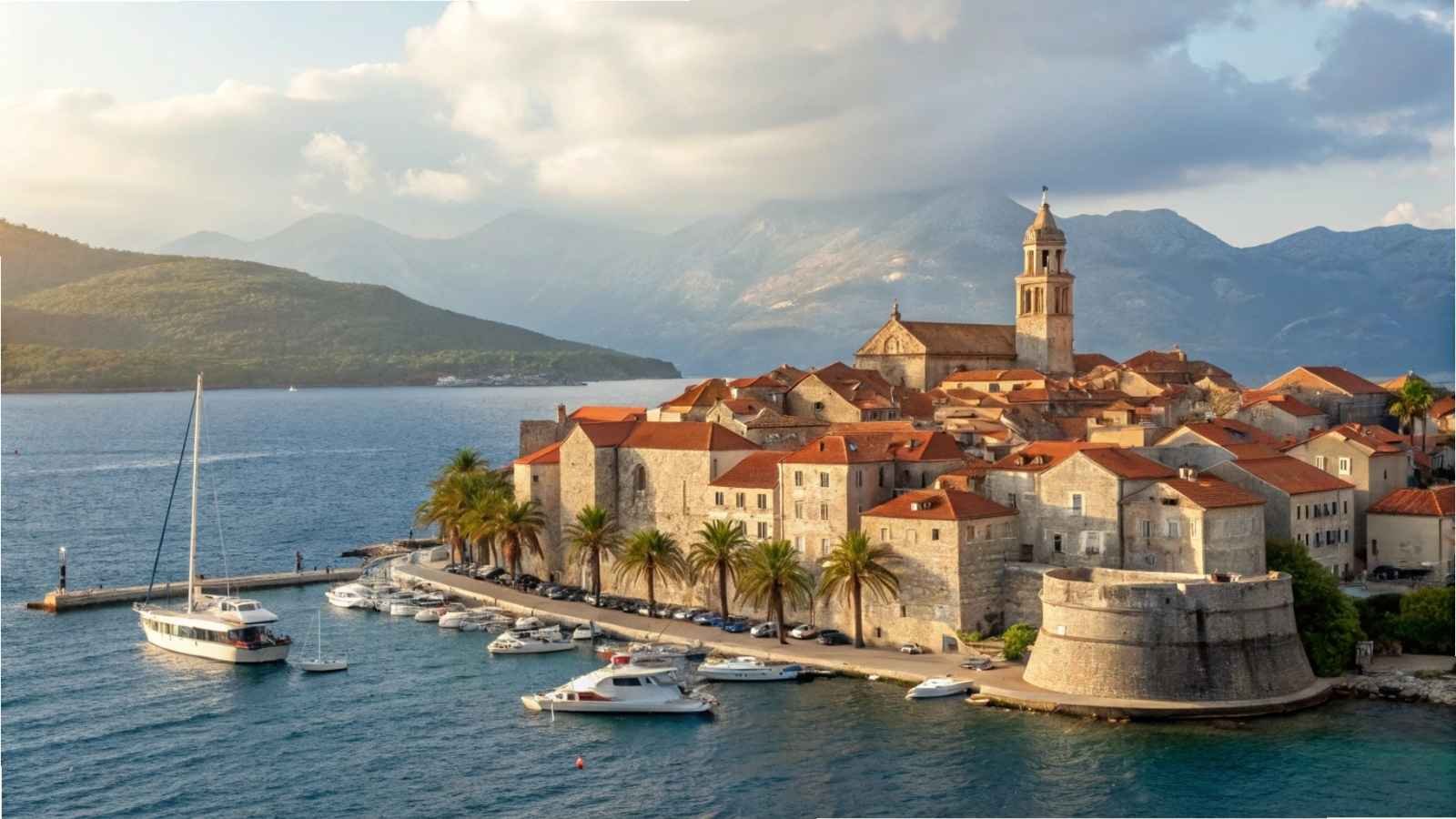
Korčula is often called “Mini Dubrovnik,” but that doesn’t quite do it justice. It has the medieval beauty and terracotta rooftops of its famous cousin, yet life here moves slower — and the sea feels closer. The old town, built on a tiny peninsula, looks like something out of a fairytale, with cobblestone alleys, ivy-covered walls, and little wine bars tucked behind ancient gates.
What sets Korčula apart is its balance: it’s cultured yet easygoing, refined but never snobby. You can cycle through olive groves, kayak between coves, or sip local Grk wine at sunset overlooking the Adriatic. Whether you’re after history, good food, or that quiet coastal glow, Korčula wraps it all together with understated class.
What to know:
- Best months to visit: May to October (June and September ideal)
- Getting there: Ferry from Split or Dubrovnik
- Where to stay: Korčula Town for atmosphere, Lumbarda for beaches
- Vibe: Historic, charming, quietly elegant
- Must-do: Sunset drinks at Massimo Bar — set inside a medieval tower
6. Antiparos, Greece
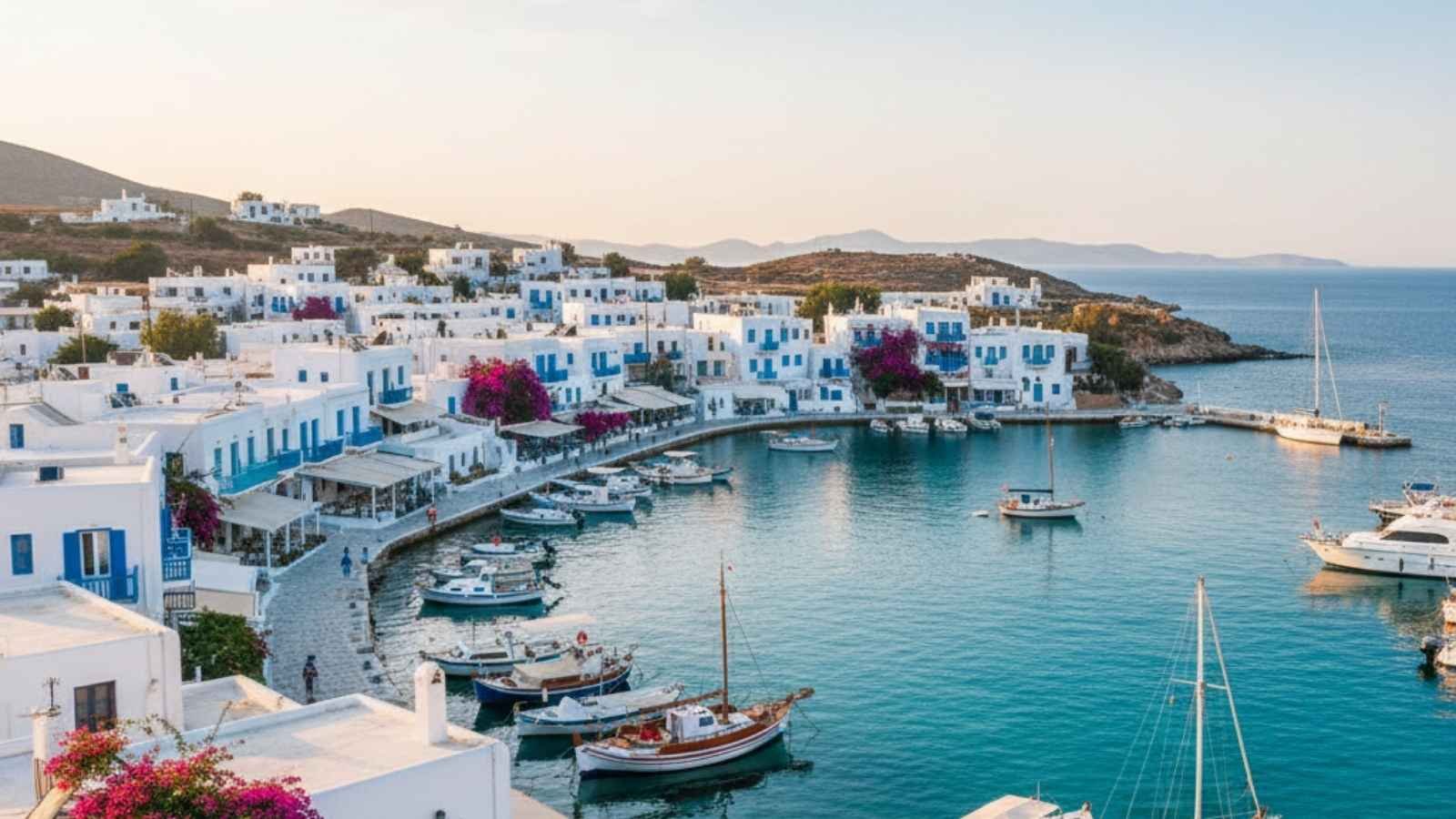
If Paros is lively and social, Antiparos is its serene younger sibling — smaller, sleepier, and effortlessly cool. It’s where Athenians and a few lucky travelers go when they want the Cycladic beauty without being “seen.” The main town, with its single charming street, feels like a scene out of old Greece — whitewashed walls, lazy cats napping under bougainvillea, and soft chatter from café patios.
You’ll find hidden beaches with powdery sand and crystal shallows, perfect for a quiet swim. Locals might point you toward Soros Beach for a chic afternoon or the legendary Antiparos Cave for a taste of the island’s wild heart. And when the evening breeze rolls in, dinner under the stars at a taverna by the sea is as authentic as it gets.
What to know:
- Best months to visit: May to early October (June and September are golden)
- Getting there: 10-minute ferry from Paros
- Where to stay: Near the main town (Antiparos Chora) for easy access
- Vibe: Intimate, easygoing, naturally elegant
- Must-do: Visit the ancient stalactite-filled Antiparos Cave — one of the oldest in Europe
7. Brač, Croatia
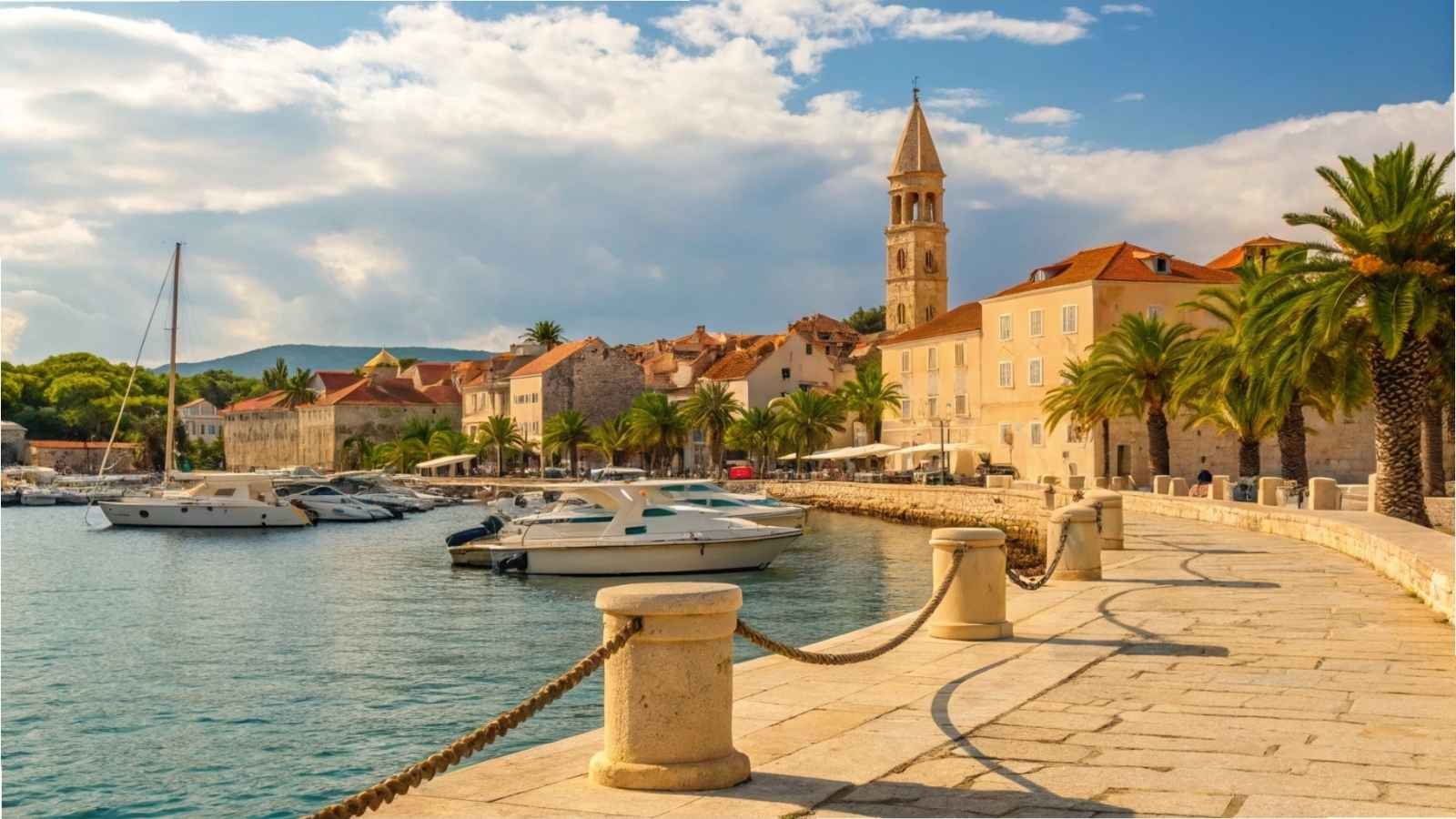
Brač is Croatia’s understated star — home to Zlatni Rat Beach, that ever-changing golden spit of sand often seen in travel ads, yet still surprisingly low-key. What makes Brač special isn’t just its beaches, though — it’s the way it balances rugged mountain terrain, historic stone villages, and clear blue water into one cohesive island experience.
The main town of Bol has a breezy, sunlit vibe, ideal for a laid-back stay. Inland, tiny hamlets like Škrip still carry echoes of ancient Croatia, offering a glimpse of everyday life beyond the coast. You can hike to Vidova Gora, the highest peak on any Adriatic island, for sweeping views that’ll stay with you long after you’ve left.
What to know:
- Best months to visit: May to September (July best for beach days)
- Getting there: 1-hour ferry from Split
- Where to stay: Bol for beaches, Supetar for family-friendly stays
- Vibe: Relaxed, sporty, scenic
- Must-do: Windsurfing or paddleboarding off Zlatni Rat’s shifting shores
8. Amorgos, Greece
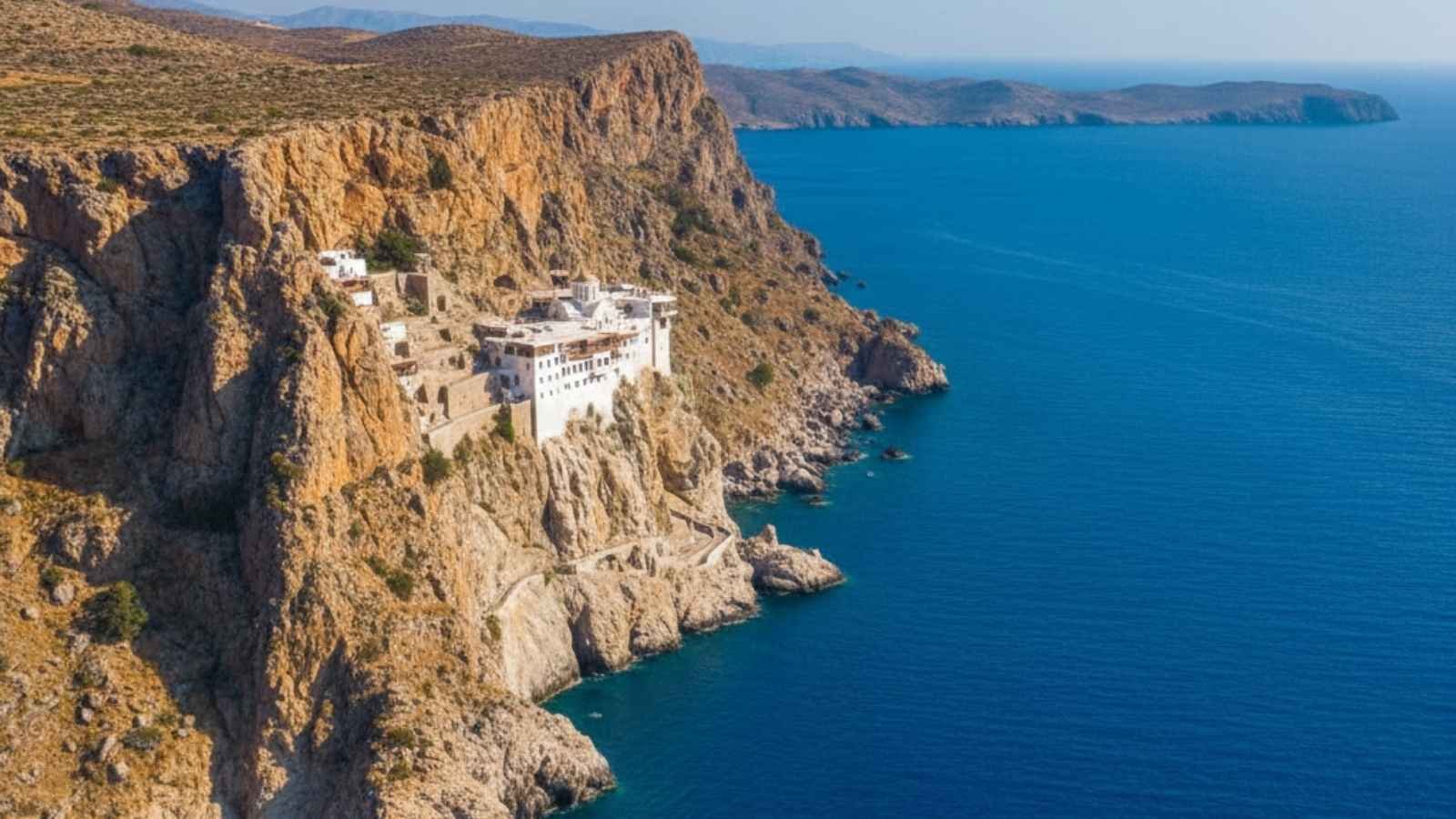
Amorgos isn’t the island you stumble upon — it’s the one you seek out. Remote, wild, and cinematic (yes, it starred in The Big Blue), it offers a raw version of Greece that feels almost spiritual. The island’s rugged cliffs dive straight into the sea, and its whitewashed villages look like they’ve grown organically from the rock itself.
One of its crown jewels is the Monastery of Hozoviotissa, clinging impossibly to a sheer cliff — a sight that leaves most visitors speechless. Trails weave through thyme-scented hills, leading to quiet coves like Mouros or Agia Anna, where the water is bluer than belief. It’s a place for reflection, simplicity, and those who love Greece in its purest form.
What to know:
- Best months to visit: Late May to September
- Getting there: Ferry from Naxos or Piraeus (4–9 hours depending on route)
- Where to stay: Katapola or Aegiali for accessibility
- Vibe: Untamed, soulful, meditative
- Must-do: Hike from Chora to the Monastery of Hozoviotissa — worth every step
9. Rab, Croatia
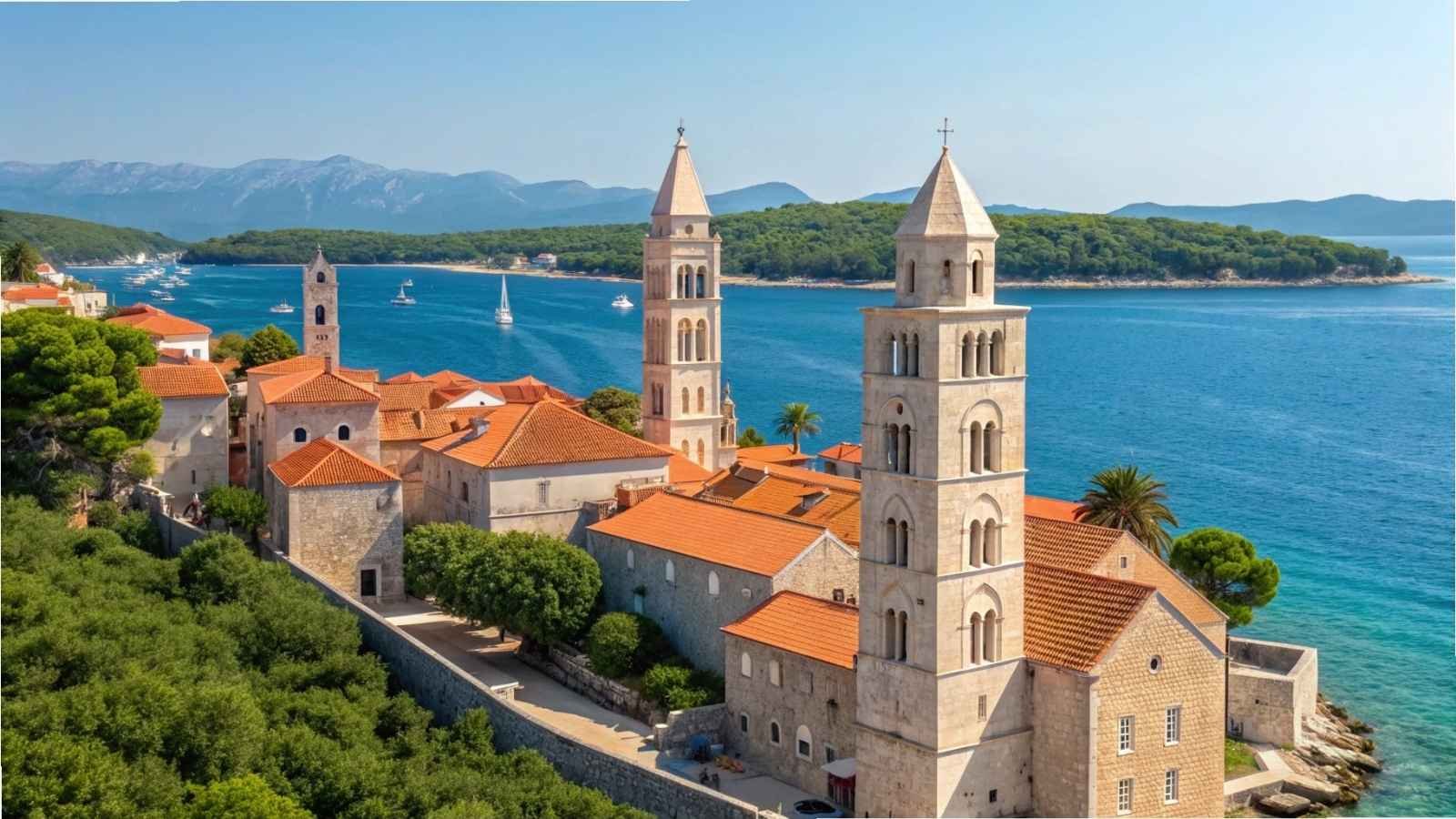
Known as the “Island of Love,” Rab has a distinctly romantic flair that dates back to when King Edward VIII visited with Wallis Simpson in the 1930s. It’s one of the lushest islands in the Adriatic — all pine forests, sandy coves, and terracotta rooftops framed by the sapphire sea. The old town, surrounded by medieval walls and four bell towers, feels both stately and cozy at once.
Rab’s beaches are a pleasant surprise — unlike most pebbly Croatian coasts, you’ll find soft sands, especially at Rajska Plaža (Paradise Beach). Days drift easily between swimming, café-hopping, and exploring the narrow alleys that snake through town. It’s relaxed without being sleepy, elegant without trying too hard.
What to know:
- Best months to visit: June to early September
- Getting there: Ferry from the mainland near Stinica
- Where to stay: Rab Town for history, Lopar for beaches
- Vibe: Romantic, green, laid-back
- Must-do: Climb the Cathedral Bell Tower for a panoramic sweep of the old town





